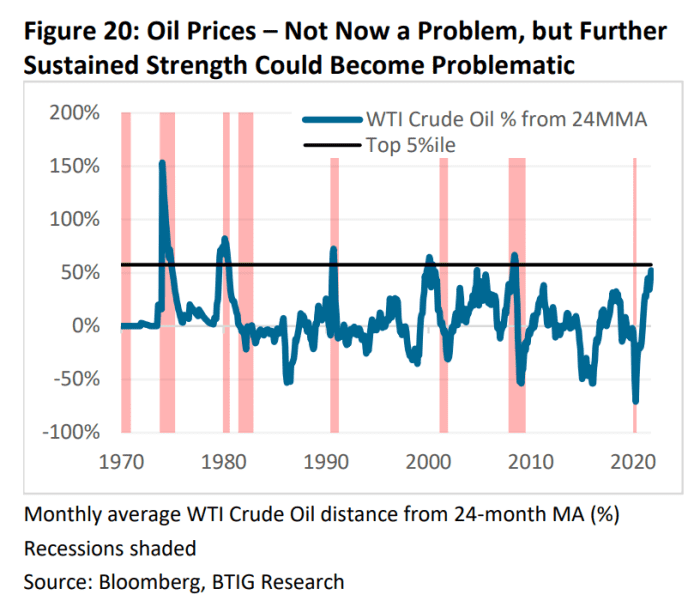This post was originally published on this site
Surging oil prices might account for some of the stock market’s sideways performance since early September, according to one Wall Street analyst, with crude knocking on the door of a level that traditionally starts to bite into economic activity.
In a Sunday note, Julian Emanuel, chief equity and derivatives strategist at BTIG, took a look at deviations from the 24-month moving average for front-month West Texas Intermediate crude futures
CL00,
He noted that the top 5% of observations, which occur when the price is 57% above the 24-month-moving average, have occurred ahead of an economic slowdown.
That 57% threshold now stands at $82 a barrel — a level that November WTI futures
CLX21,
traded at Friday as it hit a nearly 14-year high (see chart below), and exceeded Monday before turning lower.

BTIG
“Such oil-price strength is likely a contributor to the rangebound nature of [the S&P 500] since the 9/2 high, along with plateauing earnings estimates, a more hawkish Fed and mixed public flows,” Emanuel wrote.
The S&P 500
SPX,
closed at a record 4,536.95 on Sept. 2. The large-cap benchmark subsequently edged down in September, retreating 5.2% from its high through Oct. 2. The S&P 500 has since steadied, ending Friday 1.5% away from its closing record. The Dow Jones Industrial Average
DJIA,
on Friday finished less than 1% away from its record close of 35,625.40, set on Aug. 16.
Through Friday, the S&P 500 was up a robust 19% for the year to date, while the Dow had advanced more than 15%. The small-cap Russell 2000
RUT,
ended Friday 4% below its record close of 2,360.17 set on March 15, leaving it up 14% so far this year.
Past slowdowns that followed oil-price spikes “have also been accompanied by increased equity market volatility albeit with medium-term small-cap outperformance,” he said, using the table below to illustrate how past crude-price jumps have affected equities in the past.

BTIG
WTI crude has rallied 68% so far this year, while Brent crude
BRN00,
the global benchmark, was up 72%. That is a significant turnabout from April 2020, when a soon-to-expire WTI contract traded — and settled — with a negative price for the first time ever as the global economy juddered to a halt as a result of the COVID-19 pandemic.
Crude rallied as the global economy came back to life. More recently, supply strains have been cited as a main driver after a hurricane caused lingering production outages in the Gulf of Mexico and members of the Organization of the Petroleum Exporting Countries and their allies have struggled to meet increased production quotas.
Meanwhile, concerns about rising oil prices have emerged, particularly for fuel-sensitive sectors such as transportation. Delta Air Lines
DAL,
last week said the recent rise in fuel prices would pressure its ability to remain profitable in the fourth quarter.
Analysts at Renaissance Macro Research last week flagged that crude prices were nearing levels that in the past have typically crimped forward returns for the S&P 500, but also noted that sectors most sensitive to rising energy prices weren’t yet underperforming to the degree suggested by historical data.


